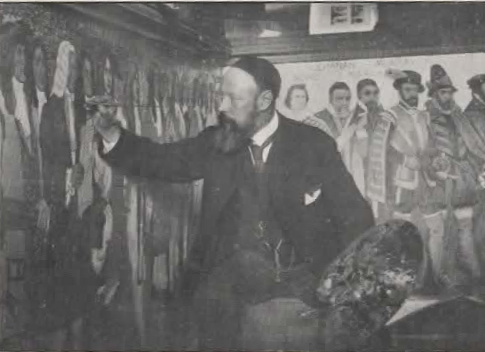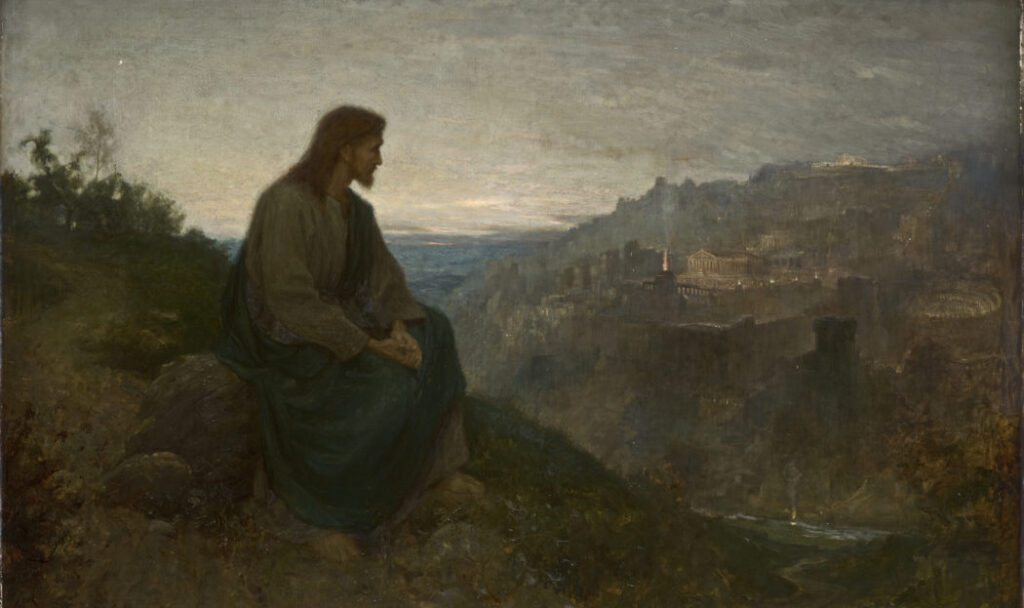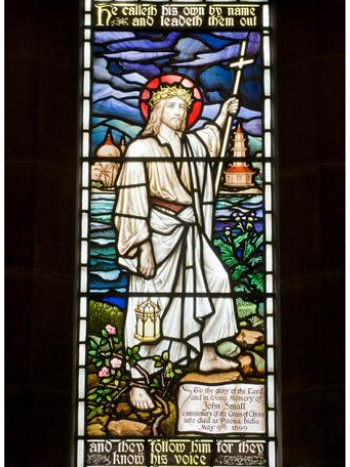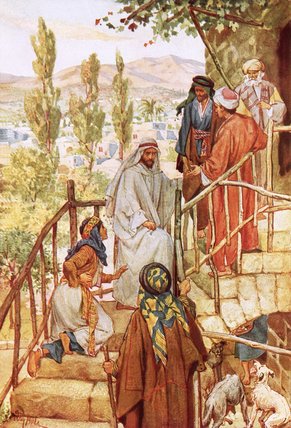10 Iconic Floral Still Lifes You Need to Know
Flowers have long been a central theme in still-life painting. Each flower carries its own symbolism. For example, they can represent innocence,...
Errika Gerakiti 6 February 2025
I invite you to take a closer look at a great Scottish etcher, muralist, and illustrator, William Hole (1846-1917) whom I discovered by chance when I found his illustrated Jesus of Nazareth book (1906) 20 years ago discarded at a sale of work. Yet Hole was a significant figure in Scottish art at the latter part of the 19th century and the beginning of the 20th. He was a great success in his day, known to his contemporaries for his historical frieze and murals in the Scottish National Portrait Gallery (1897-1901) but has been much neglected since his death in 1917.
William Hole was born in Salisbury but moved to 34 London Street, Edinburgh with his Scottish mother after his father’s death when he was three years old. Scotland became his home and his friend the Rev John Kelman believed he had “real Scottish blood in his veins” reflected in his choice of Scottish subjects such as in his Scottish National Portrait Gallery murals of key moments in Scottish history and a frieze of its 150 heroes.1

William Hole painting the Frieze for the Scottish National Portrait Gallery. Photograph in E. Hole, Memories of William Hole R.S.A. by his Wife (Edinburgh: W&R Chambers Ltd., 1920).
He really was an all rounder proficient in many disciplines, for example he was renowned in his day as an excellent etcher and even etched a portrait of James McNeil Whistler (1897). He had a wide circle of important friends from his days studying engineering including Robert Louis Stevenson and Hole illustrated many of Stevenson’s books such as Kidnapped (1887) and Dr. Jekyll and Mr Hyde (1905).
William Hole’s religious art was a focus of his output from a watershed of 1892, the death of his daughter Janet at 15 years old from meningitis. He made a significant contribution to religious art of the period mirroring the High and Low trends in the Episcopalian Church of which he was a faithful member in his artwork which ranged from sumptuous murals of the Tractarian church to authentic biblical watercolors reflecting the evangelical wing of his faith.

William Hole, If Thou Hadst Known, 1885, R.S.A. Collection, Edinburgh, Scotland.
His painting of If Thou Hadst Known (1885) became a very popular etching print (1886) and expresses sympathetically the sorrowful Christ set amid Edinburgh Rocks instead of Jerusalem (he had not yet visited the Holy Land). Hole’s High Church contribution within the Oxford Movement in Scotland is demonstrated in his illustrations of the Book of Common Prayer – Te Deum murals (1894-7) (St James’, Episcopal Church, Edinburgh) and the Benedicite (1901) (St Ninian’s Episcopal Church, Glasgow) and was influenced by the writings of Scottish Episcopalian Bishops Alexander Forbes and Bishop John Dowden.

William Hole, Benedicite, O Ye Showers and Dew Bless Ye the Lord, 1901, Mural, St Ninians Pollokshields, Glasgow, Scotland.
William Hole also supported the Celtic Renascence and its humanitarian concerns for social reform under Patrick Geddes’ Edinburgh Social Union, as well as the Celtic Church Revival within his own Episcopalian faith. He produced reredos of four Celtic saints for St Andrew’s Episcopal Church, Ardrossan (1900).2 Later Hole contributed a stained glass window of the Risen Christ for the Women’s Free Church Missionary College, Edinburgh (1908) with background reference to China and India and the flowers of the British Isles – rose, shamrock and thistle. Here he supported their ecumenical spirit also shown in his last watercolor for his book Jesus of Nazareth (1906) entitled: Where Two or More are Gathered (1906) showing the unity of all under Christ.

William Hole, He Calleth Them by Name and Leadeth Them Out, 1908, Stained Glass Window, Chapel of St Colm’s College, St Colm’s Women’s Mission Training College, Edinburgh, Scotland.
In 1901 and 1912, Hole visited the Holy Land, experiencing first hand the sights and sounds of Palestine, capturing the bleached light with his handy Kodak camera portrayed in his later more biblical focus from 1901 resulting in his 80 watercolors for Life of Jesus (1906) and 76 watercolors for his Old Testament History (1925) which had world-wide circulation. In 1949 Queen Elizabeth (then Princess) was given a copy of Hole’s Jesus of Nazareth (1906) for the young Prince Charles by the Lincolnshire Mother’s union. These watercolors, as well as his use of Spirit Fresco in his murals, have a transparency and luminosity he was seeking in which to reflect God as light.3 He tirelessly when up and down the country with his lantern slides to speak on the Life of Jesus (1906) using his illustrations to mission hall, school, and theatre. This bolstered Hole’s missionary zeal and evangelical principles and he had active church ministry, reading at church most Sundays in his own parish St James Episcopal Church, Edinburgh. His Te Deum murals were a gift to that church and Hole was very influenced by the radical young minster, Rev Charles Jenkins. Hole even ventured into the slums of Edinburgh to teach the children with a Mr Fairbairn, illustrating on the blackboard scenes from the Bible.

William Hole, Jesus Tests the Faith of a Woman, 1906, watercolour, in: Life of Jesus of Nazareth (London: Eyre and Spottiswoode, 1906).
Hole demonstrates an interest in astronomy (he owned a 3-inch telescope and gave a theory of meteorites to astronomer Sir Robert Ball). He had used a starred ceiling in the Scottish National Portrait Gallery (1897-1901) and for the background to his Benedicite murals (1901). Later in 1907, he painted a stunning Last Supper for St John’s Episcopal Church, Forres supervising re-gilding the star-studded ceiling and adding a starry backdrop to the mural but he also used a significant positioned for Christ’s face which miraculously twice a year is lit from the rose window.
Nearing his death form colon cancer in 1917, he worked on to the end completing his Old Testament History with a commentary as well as watercolors from his bed in Chalmers Private Hospital, Edinburgh. It was a fitting conclusion to a life committed to his faith and to art and its power to transform the individual. Hole deserves fresh appreciation for his contribution to religious art and a new place in art history. His Christian art, through which his deep beliefs inspired his viewer to experience his love of Christ, still, I believe, re-enchants us today.
Author’s bio:
Rosemary T McAuley, MA (hons), MTH, P.G.C.E. I have a MA (hons) in History of art with a dissertation on The Influence of Folklore and Antiquities on Selected Members of the Glasgow School and a MTh in Theology and Religious studies with a thesis on the Mysticism of William Sharp. I have just finished my thesis for a PhD in Theology and Religious Studies on Portraying His Faith :The Christian art of William Hole (1846-1917) (all University of Glasgow). I have 5 books of mystical poetry published and a children’s book (Alba Publishing). I have written articles on art and religion for Catholic life magazine and Mount Carmel magazine. I am a Christian artist and have taught art in primary and secondary schools. See my website.
J. Kelman, ‘Introduction’, The Life of Jesus of Nazareth, London: Eyre and Spottiswoode, 1906.
Reredos is the screen or panel behind the altar.
Spirit fresco is a form of varnish painting for murals using the recipe of Sir Thomas Gambier Parry (1816-1888).
DailyArt Magazine needs your support. Every contribution, however big or small, is very valuable for our future. Thanks to it, we will be able to sustain and grow the Magazine. Thank you for your help!